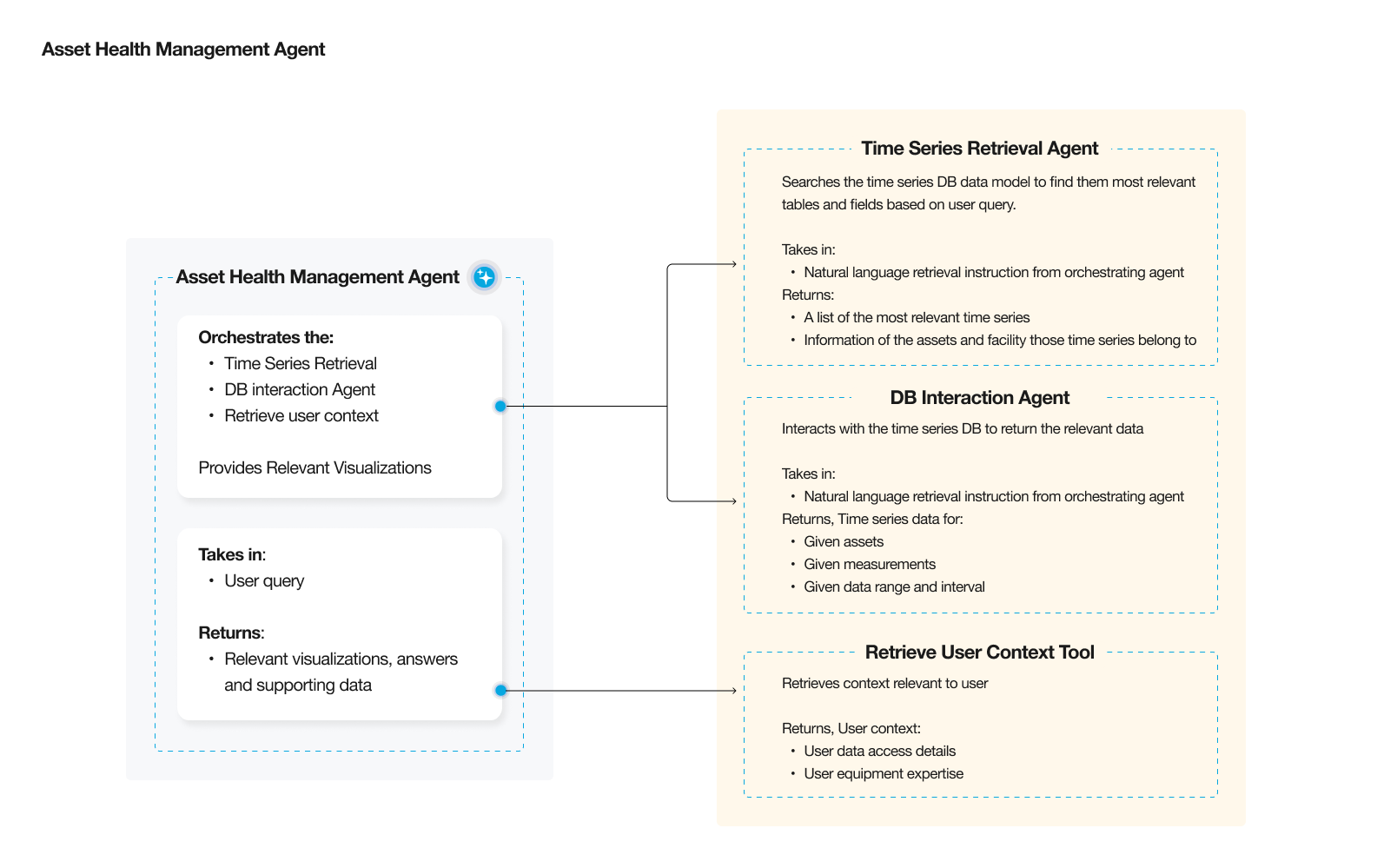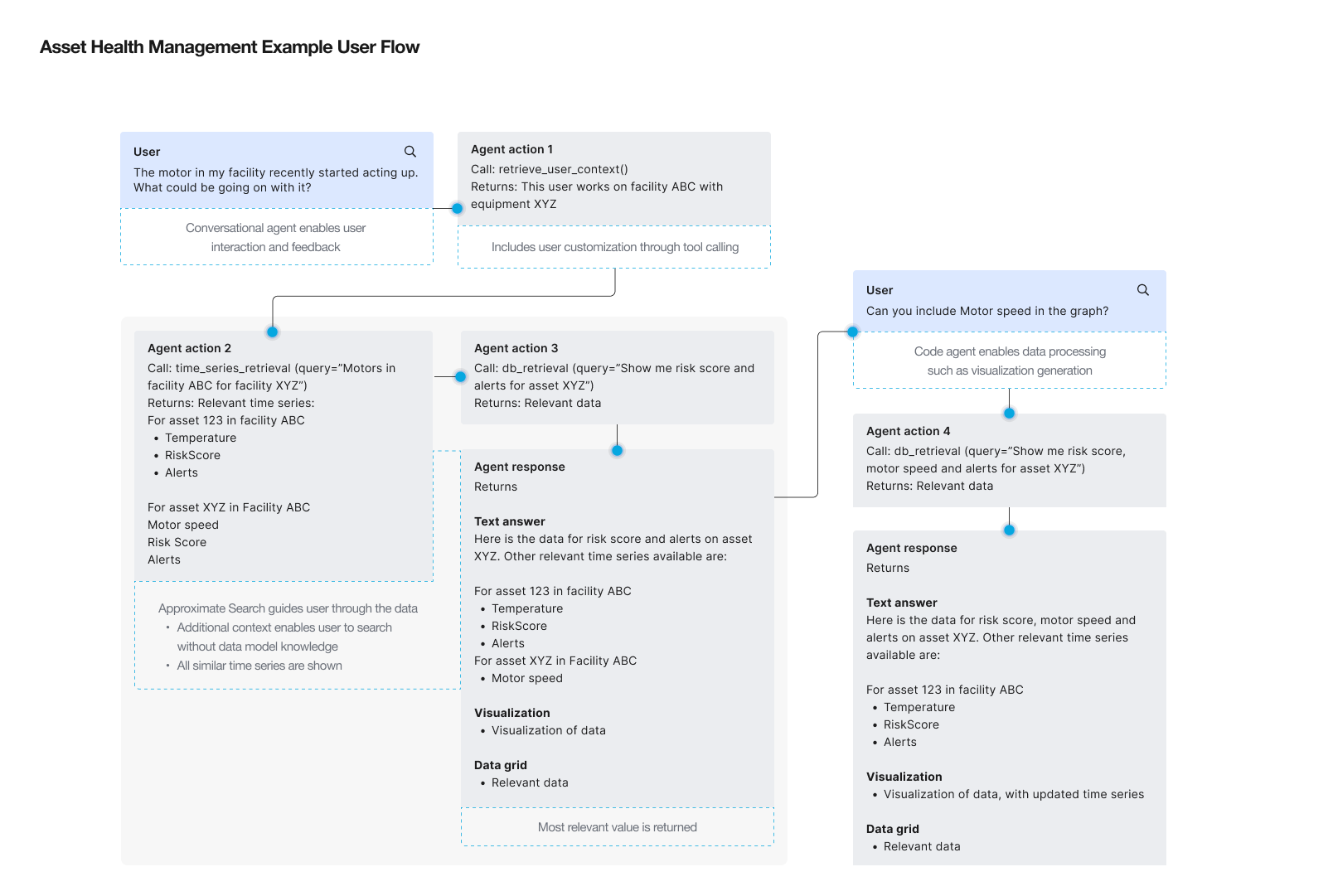A Series on Multi-Hop Orchestration AI Agents: Part 3
Continue the series: Part 1, Part 2, Part 4
By Ivan Robles, Senior Data Scientist, C3 AI
The industrial world thrives on uptime. Yet, maintaining the health of critical assets — be it turbines, engines, or industrial machinery — is a daunting challenge. Data floods in from IoT sensors, maintenance logs, and operational systems, but making sense of it in real time requires far more than traditional tools can provide. That’s where multi-hop orchestration agents come in.
C3 AI’s multi-hop orchestration agents empower organizations to overcome the challenges of asset health monitoring by providing interactive, adaptive solutions that integrate seamlessly with existing data sources.
Challenges in Asset Health Monitoring
- Data Complexity and Overload: Asset monitoring involves analyzing dynamic time series data generated by various sensors. Users often struggle to navigate the vast amounts of information to find relevant patterns or insights.
- Incomplete Knowledge of Systems: Many users are unfamiliar with database structures or the specifics of the available variables, leading to inefficiencies in data exploration and analysis.
- Real-Time Adaptation: With sensor data changing rapidly, traditional systems struggle to provide up-to-date insights necessary for predictive maintenance.
- Limited Knowledge of Data Structure: Users may not be familiar with the specific time series, sensor types, or health metrics available in the database, making it difficult to identify relevant information.
- Exploratory Data Analysis (EDA): Before conducting advanced diagnostics or predictive modeling, users must explore the data to detect patterns, trends, and early signs of asset degradation, which requires interactive exploration and visualization.
- Iterative Querying: As users explore asset health data, they typically need to refine their queries multiple times to find the most relevant insights. The system should provide real-time feedback after each iteration, helping users adjust and focus their queries more effectively.
- Data Manipulation: In addition to querying, users often need to perform time series manipulations, such as resampling, filtering, or calculating rolling averages. The system should allow for on-the-fly data transformations, enabling users to manipulate and analyze data in real-time as they explore asset health metrics.
- Real-Time Data: Given the dynamic nature of industrial environments, the system must enable real-time exploration of sensor data, offering up-to-date insights as new information is recorded, and helping users monitor asset health in real-time.
- Scalability: A scalable system requires a robust query-handling mechanism that can adapt to the high frequency and volume of requests while managing database resources to avoid overload.
Multi-Hop Orchestration Agents: The Solution
C3 AI employs a multi-agent system that addresses these challenges:
- Conversational Code-Based Orchestration Agent: Acts as the controller, translating user requests into actions and guiding the multi-agent system to deliver precise outputs.
- Time Series Retrieval Agent: Identifies relevant data streams even when users provide incomplete or ambiguous instructions.
- Database Interaction Agent: Retrieves and processes the requested data efficiently, enabling real-time exploration and manipulation.
- Interactive Visualization Tools: Offer dynamic views of sensor data, trends, and anomalies, enabling users to make informed decisions quickly.

A multi-agent system can tackle asset health monitoring challenges by enabling the following:
Conversational Code-Based Orchestration Agent
The conversational code-based orchestration agent acts as the central controller, seamlessly translating user inputs into actionable tasks executed by the multi-agent system. Its primary role is to coordinate specialized agents and streamline interactions for efficient and accurate results.
Capabilities that Streamline Asset Health Insights
- Embedding Diagnostic Logic into Data Exploration: Integrates SME-defined rules and diagnostic logic to streamline the exploration of health metrics and sensor data, ensuring insights align with asset-specific characteristics and operational priorities.
- Guiding Data Retrieval: Coordinates with the Time Series Retrieval and DB Interaction Agent to retrieve relevant time series data, such as sensor readings or maintenance logs, even if users are unfamiliar with the exact database structure or variable names.
- Providing Interactive Visualizations: Enables real-time visualizations of asset health, including sensor readings, anomalies, and trend patterns, to help users understand performance and identify early signs of degradation.
- Enabling Iterative Querying and Feedback: Establishes an interactive feedback loop that guides users through iterative query adjustments, allowing them to refine searches and uncover more precise insights as they explore asset data.
Specialized Agents for Targeted Tasks
- Time Series Retrieval Agent: This agent specializes in identifying relevant time series data based on user inputs, even if the instructions are incomplete or imprecise. Using semantic matching, it connects loosely defined queries to the most appropriate data.
Example: If a user requests “temperature readings for the engine,” the agent can suggest specific variables like “asset_thermal_sensor_01_ASD” or “engine_temp_sensor_AGF_DS” without requiring knowledge of exact database details.
- Database Interaction Agent: After the retrieval agent pinpoints the required data, the database interaction agent executes precise queries to fetch the information. It operates strictly on defined instructions, delivering data that aligns with user parameters without interpreting requests.
Tools to Enhance Efficiency and Context
- Retrieve User Context Tool: This tool enhances the system’s efficiency by providing relevant user context, such as facility information, access details, or user equipment expertise. For instance, it can identify which facility or asset a user is querying about, streamlining the retrieval process.
How It All Works Together

Real-World Benefits
For a leading manufacturing firm, implementing C3 AI’s multi-hop orchestration agents reduced equipment downtime by 30% while cutting maintenance costs by 25%. The agents’ ability to provide iterative feedback allowed the company to identify and resolve potential issues before they escalated into costly failures.
Transforming Asset Management
With multi-hop orchestration agents, businesses can:
- Conduct exploratory data analysis to detect early signs of degradation.
- Perform real-time data transformations like resampling or filtering.
- Automate workflows to streamline maintenance processes.
By turning complex data streams into actionable insights, C3 AI’s solutions ensure organizations stay ahead of potential failures, extending the lifespan of critical assets while improving operational efficiency.
About the Author
Ivan Robles is a Lead Data Scientist on the Data Science team at C3 AI, where he develops machine learning and optimization solutions across a variety of industries. He has a record of AI Kaggle competitions, where he ranked on the top 1.5% globally. He received his Master of Science in Advanced Chemical Engineering with Process Systems Engineering from Imperial College London.



